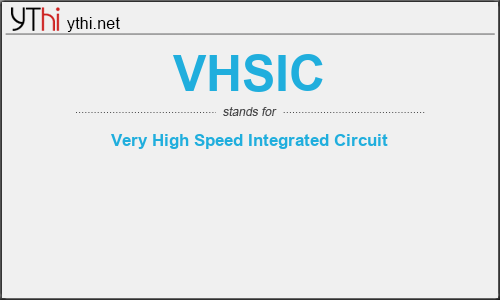What does VHSIC mean? What is the full form of VHSIC?
The full form of VHSIC is Very High Speed Integrated Circuit.
Very high speed integrated circuits (VHSIC) was a 1980s U.S. government program. The program’s mission was to research and develop very high speed integrated circuits.
The United States Department of Defense launched the VHSIC program in 1980 as a joint tri-service (Army/Navy/Air Force) program. The program led to advances in integrated circuit materials, lithography, packaging, testing, and algorithms, and created numerous computer-aided design (CAD) tools. A well-known part of the program’s contribution is VHDL (VHSIC Hardware Description Language), a hardware description language (HDL). The program also redirected the military’s interest in GaAs ICs back toward the commercial mainstream of CMOS circuits.
More than $1 billion in total was spent for the VHSIC program for silicon integrated circuit technology development.[3]
The U.S. Department of Defense has funded $324 million to-rnvestigate and test integrated circuitry so compact and so fast that it could reduce size by a factor of ten, cut power demands by up to 80 percent and increase overall capability, ease of repair and replacement and interoperability by huge margins. The application of this technology is for defense electronics but the spinoffs are many and varied. VHSIC technology will have a dramatic impact on biomedical engineering. Processors that now occupy the volume of a cubic foot or more will be fabricated on a couple of plug-in cards and they will be capable of performing hundreds of millions of operations per second. This paper summarizes the objectives of the VHSIC program and arlrlresses the application of VHSIC technology to modern prosthetics and orthotics.
While there are already a number of packages available either in the public domain or commercially, there are numerous classifications of design techniques and areas in which additional VHDL packages would benefit the industry. These include: (a) Back-Annotation, (b) Math routines, (c) Floating-Point, (d) Digital Signal Processing Functions and (e) Abstract Queing. In phase I of the proposed work, a survey of the most needed packages will be conducted and a specification will be written to further develop the packages under Phase II. Therefore the goals are: 1. Develop an industry survey asking users to describe the features in any of the packages mentioned above and gain feedback on requirements for packages other than those identified based upon the industry’s needs. 2. Develop a draft specification for each pakcage. In those cases where the functionality can be so well defined as to specify the procedural interfaces, this specification may be as detailed as a VHDL package declaration, or alternatively the specification may describe the subprograms and types needed in the abstract and leave the detailed design for Phase II. This effort will be accomplished in coordination with the efforts of the IEEE and the industry with the goal of providing VHDL packages not readily available elsewhere.
VHSIC
means
Very High Speed Integrated Circuit![]()
Translate Very High Speed Integrated Circuit to other language.


Leave a Reply
You must be logged in to post a comment.